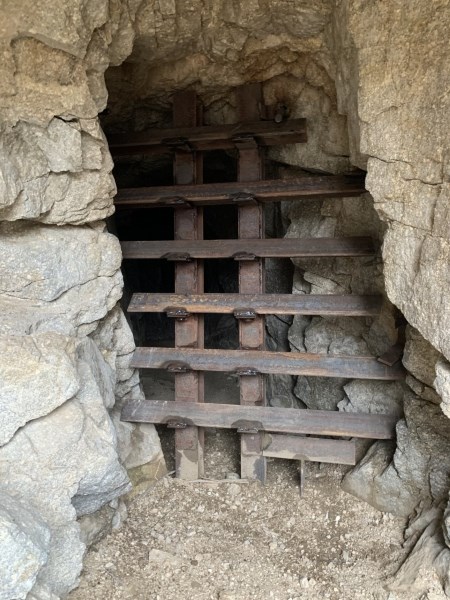Last updated: April 29, 2023
Article
Closing Abandoned Mines

NPS / Stacy Manson
Gold Rush Days
The striking rock formations in Joshua Tree National Park (JTNP) are laced with veins of quartz—and sometimes, this quartz contains gold. Starting in the 1870s (long before the park was established) this region attracted miners who dreamed of striking it rich.
Very few were successful—although between 1984 and 1931 one notable site, the Lost Horse Mine, did produce gold and silver worth around $5 million in today’s dollars. Mining and prospecting in the region mostly stopped in the 1930s, and Joshua Tree National Monument was established in 1936.
Old Mines Are Dangerous
The legacy of mining is readily visible today. Within the boundaries of what is now a national park are about 300 abandoned mining sites with more than 720 mine openings. Visitors are often intrigued by the idea of exploring old mines, but abandoned mine workings pose a serious resource management challenge for the park.
An estimated 120 of the abandoned mine sites have substantial openings classified as “extremely hazardous”—meaning a fall would likely cause serious injury or death. These openings include vertical shafts, adits (horizontal shafts), and inclines (angled shafts).
Other hazards to curious visitors include rotting ladders, the risk of cave-ins, abandoned explosives, deadly gases that can fill deep shafts, mine tailings (processed rock) contaminated with mercury and cyanide, and unsafe structures such as rusting fuel storage tanks, deteriorating buildings, and abandoned heavy machinery.
Making Mines Safe for People . . . and Wildlife
For more than 20 years, JTNP has been working to make abandoned mine sites safer. In 2008, the U.S. Department of the Interior Office of Inspector General commended the park for using best practices related to mine closures.
The main goal of the park’s AML Program is to close the most hazardous mines and keep visitors safe. Some old mines in the park are considered historic and are protected under the National Historic Preservation Act, so another goal is to make those areas safe for visitors, turning them into cultural resources that tell the history of mining in California.
In addition, some old mines are now habitat for wildlife. Desert tortoises, snakes and lizards, and many desert rodents find refuge in the cool, dark mine shafts, along with cave-roosting bats. Where wildlife have moved in, the park must secure the openings to mines in a way that keeps people out, but allows animals to come and go freely.

NPS Photo
More Than One Way to Close a Mine
To achieve these goals, the park supports an interdisciplinary team that specializes in mine closure techniques. One of this team’s first steps was to evaluate the most hazardous mines and determine the appropriate treatment. One treatment option is to plug (fill in) the mine opening, leaving some evidence of mining in place. Another option is to install "wildlife-friendly enclosures," a variety of openwork metal structures, including grates, wire nets, “cupolas” (cage-like structures installed over shafts), graded culverts, or fences—all designed to exclude people, but let wildlife in and out.
To plug or fill in a mine shaft, the park AML team often uses an innovative technique: Instead of backfilling with rocks and dirt, they plug the opening with expanding polyurethane foam (PUF), which is later topped with a layer of dirt to conceal the opening. This approach has several advantages. At some sites, there’s simply not enough loose dirt and rocks on site to fill the old shaft. The foam is stable and doesn’t leach hazardous chemicals. It’s inexpensive, the materials are relatively light and easily transported to remote sites, and the plug is like a cork in a bottle; it could be removed if there were ever a reason to reopen the mine.
Another advantage of using PUF: It helps to preserve some features of the cultural landscape. A depression is left behind to show where the historic mine was located, and some piles of mine tailings may be left in place. For sites that require wildlife-friendly enclosures, the park’s machine shop has the tools needed to build custom structures. Mine openings are measured in the field, the shop prefabricates the metal structures needed to close the site, and then the components are assembled on site.
For backcountry mines not reachable by road, the park contracts for helicopters to transport the necessary tools and materials to and from mine sites. This approach has proven cost and time-efficient with low environmental impacts.

NPS/Stacy Manson
Accomplishments and Goals
The park’s mine closure efforts got a boost in 2009 when JTNP received funding through the American Recovery and Reinvestment Act to close 22 abandoned mines (with 40 total openings). Closures continued at a steady pace over the next decade.
In 2022, additional funding for mine closures in JTNP was awarded through the Bipartisan Infrastructure Law; since then the park team has plugged four hazardous mine openings using PUF, protected another two openings with wildlife-friendly enclosures, and repaired vandalized gates and fences to close four other openings. Altogether, between 2003 and 2023, the park has closed more than 90 mine openings at about 40 mines.
Over the next decade, the park will continue to mitigate mine sites until all of the openings classified as extremely hazardous are closed. The park's AML team will then refocus their efforts on repairing and maintaining these closures. Less hazardous mine openings will be evaluated and closed if necessary.
